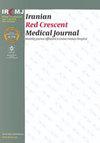Assessment of Positive Airway Pressure Treatment Adherence and Sleep Quality in Sleep Apnea Patients During COVID-19 Pandemic: Multi-center Cross-sectional Study Results
IF 0.2
4区 医学
Q3 MEDICINE, GENERAL & INTERNAL
引用次数: 0
Abstract
Background: Patients with obstructive sleep apnea (OSA), related to their disease consequences and treatment modalities, are physically and mentally vulnerable during the outbreak. Objectives: To investigate the association between pandemic-related changes and positive airway pressure (PAP) adherence and sleep quality in OSA patients. Methods: This was a multi-center cross-sectional study, and the necessary data were collected prospectively. A total of 221 patients were included in the study, who were invited from four different centers from June 1 - December 1, 2020. Pittsburgh Sleep Quality Index (PSQI) was administered to evaluate sleep quality. Information on demographics positive airway pressure (PAP) device use, Coronavirus disease (COVID-19) a questionnaire collected related changes. Patients >18 years with a diagnosis of OSA and prescribed PAP treatment before the pandemic period were included in the study. Lack of cooperation with the questionnaires and incompliant with PAP treatment for longer than one year were the exclusion criteria. Results: Of the 221 participants, 79.2% were men. The mean apnea-hypopnea index was obtained at 40.8±24.3. A positive COVID-19 test was reported in nine cases, and three patients had hospitalization. During the pandemic, 102 (46.2%) subjects were retired, 26 (11.8%) lost their jobs, and 34 (15.3%) reported home office work or on-call or on leave. Poor sleep quality was found in 54 (24.4%) individuals. It was also reported that poor sleep quality was more common in those who reported mask use difficulty (38.7% vs. 18.9%; P=0.004) and increased or decreased PAP use (increased, decreased, no change in PAP use: 45.5%, 36.0%, 19.4%, respectively; P=0.01). The good sleep quality group had higher PAP use than the poor sleep quality group (6.2±1.5 vs. 5.3±2.4 night/week; P=0.002; 6.2±1.5 vs. 5.5±2.2 hour/night; P=0.01). Conclusions: Pandemic period had several negative effects on sleep apnea patients regarding sleep quality and social lives which also influenced PAP adherence in OSA patients. Most patients did not change their regular PAP use attitudes during this period. Similar to the pre-COVID-19 disease period, PAP adherence and compliance positively influenced sleep quality; people who were "good sleepers" were the ones who were the "good PAP device users".新冠肺炎大流行期间睡眠呼吸暂停患者气道正压治疗依从性和睡眠质量的评估:多中心交叉研究结果
背景:阻塞性睡眠呼吸暂停(OSA)患者与其疾病后果和治疗方式有关,在疫情期间身体和精神都很脆弱。目的:研究OSA患者的流行病相关变化与气道正压通气(PAP)依从性和睡眠质量之间的关系。方法:这是一项多中心横断面研究,前瞻性地收集必要的数据。共有221名患者参与了这项研究,他们于2020年6月1日至12月1日从四个不同的中心接受了邀请。匹兹堡睡眠质量指数(PSQI)用于评估睡眠质量。关于人口统计学信息的气道正压通气(PAP)设备使用、冠状病毒疾病(新冠肺炎)问卷收集的相关变化。本研究纳入了在疫情期间之前诊断为OSA并接受PAP治疗的18岁以上患者。不配合问卷调查和不接受PAP治疗超过一年是排除标准。结果:221名参与者中,男性占79.2%。平均呼吸暂停低通气指数为40.8±24.3。报告有9例新冠肺炎检测呈阳性,3名患者住院治疗。在疫情期间,102名(46.2%)受试者退休,26名(11.8%)失业,34名(15.3%)报告在家办公或随叫随到或休假。54人(24.4%)的睡眠质量较差。另据报道,睡眠质量差在那些报告口罩使用困难(38.7%对18.9%;P=0.004)和PAP使用增加或减少(PAP使用的增加、减少、无变化:分别为45.5%、36.0%、19.4%;P=0.01)的人中更常见。睡眠质量好组的PAP使用量高于睡眠质量差组(6.2±1.5 vs.5.3±2.4夜/周;P=0.002;6.2±1.5 vs 5.5±2.2小时/夜;P=0.01)。结论:流行期对睡眠呼吸暂停患者的睡眠质量和社交生活产生了一些负面影响,也影响了OSA患者的PAP依从性。在这段时间里,大多数患者没有改变他们常规使用PAP的态度。与COVID-19疾病前时期类似,PAP依从性和依从性对睡眠质量有积极影响;“睡眠良好”的人就是“良好的PAP设备用户”。
本文章由计算机程序翻译,如有差异,请以英文原文为准。
求助全文
约1分钟内获得全文
求助全文
来源期刊

Iranian Red Crescent Medical Journal
MEDICINE, GENERAL & INTERNAL-
CiteScore
1.16
自引率
0.00%
发文量
0
期刊介绍:
The IRANIAN RED CRESCENT MEDICAL JOURNAL is an international, English language, peer-reviewed journal dealing with general Medicine and Surgery, Disaster Medicine and Health Policy. It is an official Journal of the Iranian Hospital Dubai and is published monthly. The Iranian Red Crescent Medical Journal aims at publishing the high quality materials, both clinical and scientific, on all aspects of Medicine and Surgery
 求助内容:
求助内容: 应助结果提醒方式:
应助结果提醒方式:


